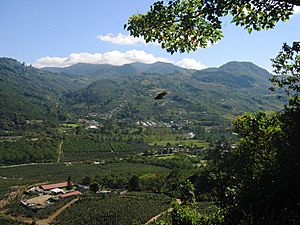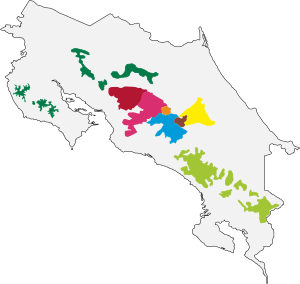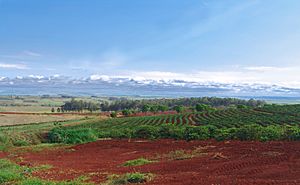Coffee production in Costa Rica facts for kids

Coffee production is very important to Costa Rica. It has shaped the country's history and still plays a big part in its economy. For many years, coffee was Costa Rica's top export crop. In 2006, it was the third most important export. Many people in Costa Rica work in farming, and this sector makes up a good portion of the country's total income. The main places where coffee grows are in the provinces of San José, Alajuela, Heredia, Puntarenas, and Cartago. Costa Rica exports its coffee all over the world.
Even though Costa Rica is a small country, it produces less than 1% of the world's coffee. In 2015, the country earned about $305.9 million from coffee exports. This was a small part of its total exports. Coffee production changes each year. It went up in 2015-2016, then down in 2016-2017, but was expected to rise again.
Contents
History of Coffee in Costa Rica
Coffee farming in Costa Rica started in 1779. The central area, called the Meseta Central, had perfect soil and weather for coffee plants. The type of coffee plant, Coffea arabica, came to Costa Rica directly from Ethiopia.
In the 1800s, the Costa Rican government really wanted farmers to grow coffee. They even gave land to anyone who would plant coffee. This helped the coffee industry grow a lot. Soon, coffee became the main source of money for the country. It earned more than cacao, tobacco, and sugar by 1829.
When Costa Rica became independent from Spain in 1821, coffee exports to Panama continued. In 1832, Costa Rica started sending coffee to Chile. From Chile, it was then shipped to England. In 1843, a man named William Le Lacheur sent coffee directly to the United Kingdom. The British saw how good Costa Rican coffee was. They invested a lot of money in the industry. This made Britain the main buyer of Costa Rican coffee until World War II.
The money from coffee helped Costa Rica grow and become more modern. It paid for young students to study in Europe. It also funded the first railroads in 1890. These railroads connected the country to the Atlantic Coast. The famous National Theater in San José was also built with money from early coffee farmers.
Coffee was very important to Costa Rica's economy in the early to mid-1900s. The leading coffee growers were important people in society. Because coffee was so central, changes in coffee prices around the world greatly affected Costa Rica. If the price of coffee dropped, it could hurt the country's economy a lot.
In 1955, a tax was added to coffee exports. In 1983, a serious plant disease hit the coffee industry. This happened at the same time that world coffee prices fell. By the late 1980s, coffee production went up, but the money earned from it went down. In 1989, Costa Rica and other Central American countries worked together. They made a plan to sell coffee slowly to keep prices stable.
Today, less coffee is grown around the capital city of San José. This is because cities are growing into the countryside. Farmers sometimes have to sell their land to building companies.
How Coffee is Produced
Coffee farms in Costa Rica often use workers who come from Nicaragua. These workers are paid for each basket of coffee berries they pick. The berries are then taken to special processing plants. In Costa Rica, these plants are called beneficios. Here, the berries are washed, and the outer pulp is removed from the beans. This process can sometimes cause environmental problems, which we will talk about later.
After washing, the coffee beans are spread out to dry in the sun. Then, they are sorted by size and shape. While some places use machines to dry the beans, many still use sun drying. Once the beans are dry and sorted, they are put into large bags. They are stored until they are ready to be exported.
Eight Growing Regions and Seasons
Costa Rica has eight main coffee-growing regions. The best coffee usually grows at high altitudes, between 1,200 and 1,700 meters. This coffee has a shorter harvest season in winter. Lower quality coffee grows below 1,200 meters. Its harvest season is longer, from late summer into winter.
The table below shows the different regions, their altitudes, harvest times, and coffee qualities.
| Altitude | Harvest | Blend Nature | Region | Subregion | 600 | 700 | 800 | 900 | 1000 | 1200 | 1300 | 1350 | 1400 | 1600 | 1650 | 1700 | 1900 | Jun | Jul | Ago | Sep | Oct | Nov | Dec | Jan | Feb | Mar | Acidity | Body | Aroma | |||||||||||||||||||||||||
|---|---|---|---|---|---|---|---|---|---|---|---|---|---|---|---|---|---|---|---|---|---|---|---|---|---|---|---|---|---|---|---|---|---|---|---|---|---|---|---|---|---|---|---|---|---|---|---|---|---|---|---|---|---|---|---|
| Valle Occidental | Very good | Very good | Very good | ||||||||||||||||||||||||||||||||||||||||||||||||||||
| Tarrazú | High, fine, not pungent | Good | Excellent | ||||||||||||||||||||||||||||||||||||||||||||||||||||
| Tres Ríos | Very high, fine | Very good | Very good | ||||||||||||||||||||||||||||||||||||||||||||||||||||
| Orosi | Medium to light | Good | Good | ||||||||||||||||||||||||||||||||||||||||||||||||||||
| Turrialba | Normal | Little | Good | ||||||||||||||||||||||||||||||||||||||||||||||||||||
| Valle Central | High, very fine | Very good | Very good | ||||||||||||||||||||||||||||||||||||||||||||||||||||
| Guanacaste | San Carlos, Sarapiquí | Balanced | Balanced | Balanced | |||||||||||||||||||||||||||||||||||||||||||||||||||
| Nicoya Peninsula | Balanced | Balanced | Balanced | ||||||||||||||||||||||||||||||||||||||||||||||||||||
| Puntarenas | Balanced | Balanced | Balanced | ||||||||||||||||||||||||||||||||||||||||||||||||||||
| Brunca | Coto Brus | Normal | Normal | Normal | |||||||||||||||||||||||||||||||||||||||||||||||||||
| Pérez Zeledón | Excellent | Excellent | Excellent | ||||||||||||||||||||||||||||||||||||||||||||||||||||
Reputation of Costa Rican Coffee
Many people think Costa Rican coffee beans are among the best in the world. The Tarrazú region is known for producing the most desired coffee beans. A special type of coffee called Geisha coffee started being grown in Tarrazú in 2012. This was after Panama's Geisha coffee became very famous. Tarrazú Geisha coffee even became the most expensive coffee sold by Starbucks in some of their stores.
The Agriculture and Livestock Ministry and the Costa Rican Coffee Institute hold a special event each year called National Coffee Day. During this event, a farmer wins the "Cup of Excellence" award for growing the highest quality coffee in Costa Rica. The winning coffee is then sold to buyers around the world through an auction.
Environmental Impact of Coffee Farming
While coffee production brings a lot of money to Costa Rica, it can also cause environmental problems. The main issue is river pollution. This happens during the cleaning and de-pulping process at the beneficio plants. After the beans are separated from the pulp, they soak in water to remove a sticky gel. This process creates leftover pulp and sugary water. In the past, many coffee producers simply dumped this waste directly into rivers.
About 57% of the coffee bean waste can pollute the water. This pollution can harm wildlife in the rivers. When the pulp decays in the water, it uses up the oxygen. This can kill fish and other aquatic life.
By the early 1990s, this problem became a big concern. In 1995, the government passed new laws. These laws set rules for how coffee producers must handle their waste. Some farmers now try to use the pulp waste as fertilizer for their soil.
Another environmental concern is deforestation. This means cutting down forests to make space for coffee farms. Deforestation can lead to soil erosion, where the soil is washed away by rain. Major deforestation in Costa Rica started in the 1830s when coffee farming began in the Meseta Central. By the 1900s, forests were being cut down even faster in other parts of the country. Coffee grew well in the volcanic mountain areas. But as demand for coffee grew, farming spread to more fragile hill forests. By the 1970s and 1980s, Costa Rica was losing about 4% of its forests each year. This was one of the highest rates in Latin America. Land used for coffee or cattle can easily erode when it rains.
See also
 In Spanish: Café de Costa Rica para niños
In Spanish: Café de Costa Rica para niños




